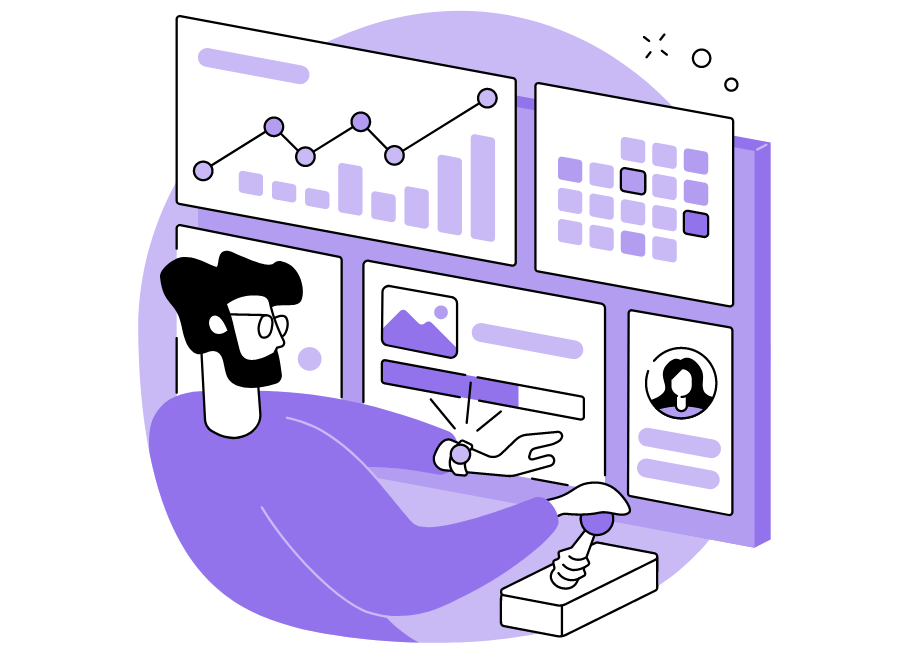
All projects have to begin one way or another.
Whether an email, an instant message, or a meeting, you have to communicate the next overarching task you and your team will take on somehow.
For maximum productivity, however, we suggest you organize a formal meeting.
Emails and instant messages get lost and overlooked easily, whereas the live element of a meeting will communicate the seriousness necessary for a new business undertaking.
This type of meeting is called a project kickoff meeting, and this article will teach you everything you need to know to organize one in software development.
Table of Contents
What is a project kickoff meeting
A project kickoff meeting is the first step towards getting the job done right.
This initial meeting between a project team and the client occurs early on in the project life cycle—in the project initiation phase.
Because it happens at the very beginning of the project, the meeting is the perfect opportunity to discuss goals, establish the project’s intention and prepare guidelines on expectations.
This is the time to drill down and detail the exact requirements.

Bug & crash reporting tool for mobile apps.
For example, it is a frequent request to improve the website user experience. The kickoff meeting is the time to define what improvement entails.
How many clicks should there be between the homepage and the checkout page? What does a customizable avatar mean?
Do users have the option of only changing their avatar’s hair and eye color or can they also change the skin type?
The project kickoff meeting is the perfect time to ask stakeholders these questions and present the product they will eventually receive. In the words of Steve Jobs:
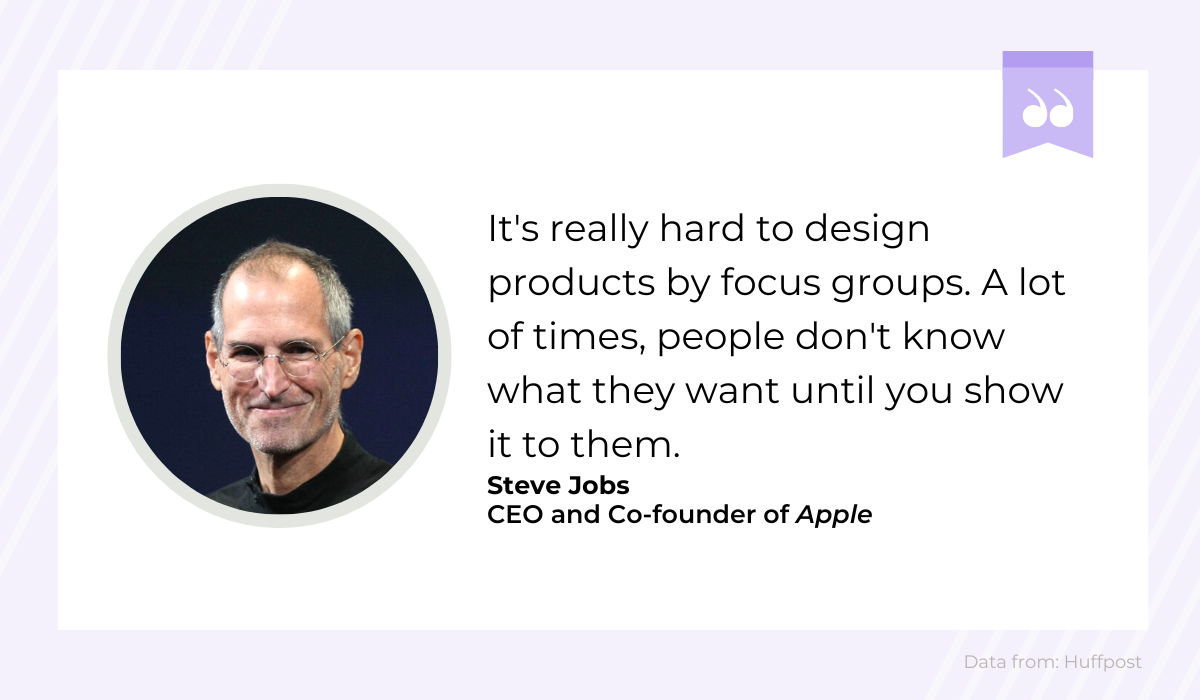
Use the project kickoff meeting to present the product you’re building to the stakeholders and receive immediate feedback if it’s what they envisioned.
Furthermore, a good, properly-timed kickoff meeting also serves as an excellent motivator for your developers. There’s even a Quora thread on this topic:
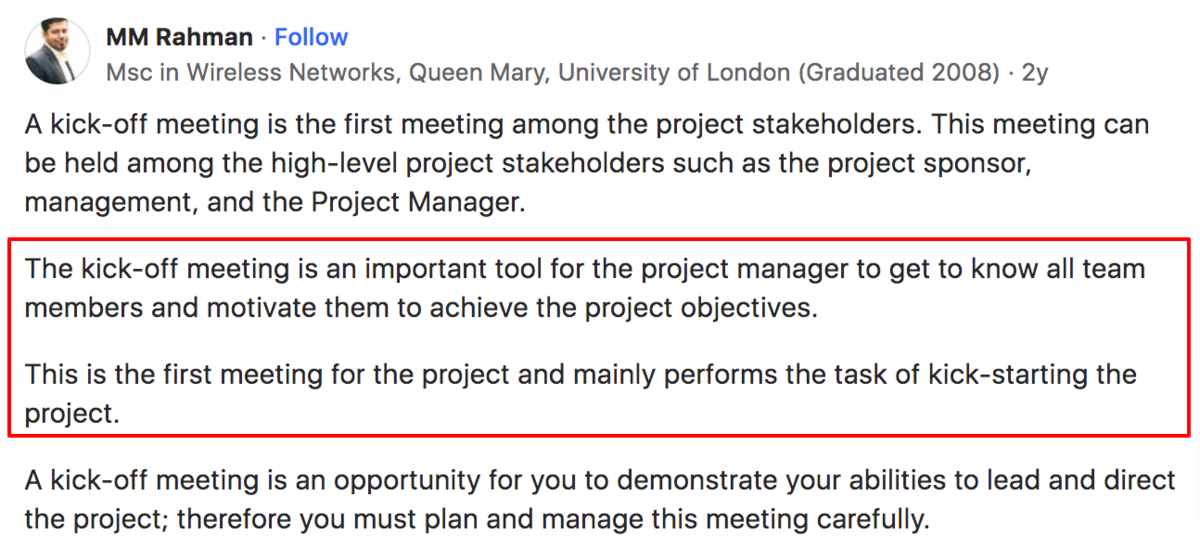
If you can host a quality kickoff meeting, your developers should go into the project feeling energized and energetic.
Such a mindset should greatly facilitate their work, and the development process will start smoothly.
Why do you need a project kickoff meeting
To complete a project, you will require a hefty amount of organization.
Although drive, innovation, and a positive attitude are huge facilitators when working on software development projects, they’re still no replacement for objective planning and logistics.
The importance of a quality plan was revealed in a recent survey, as some sobering statistics about technology projects came to light:
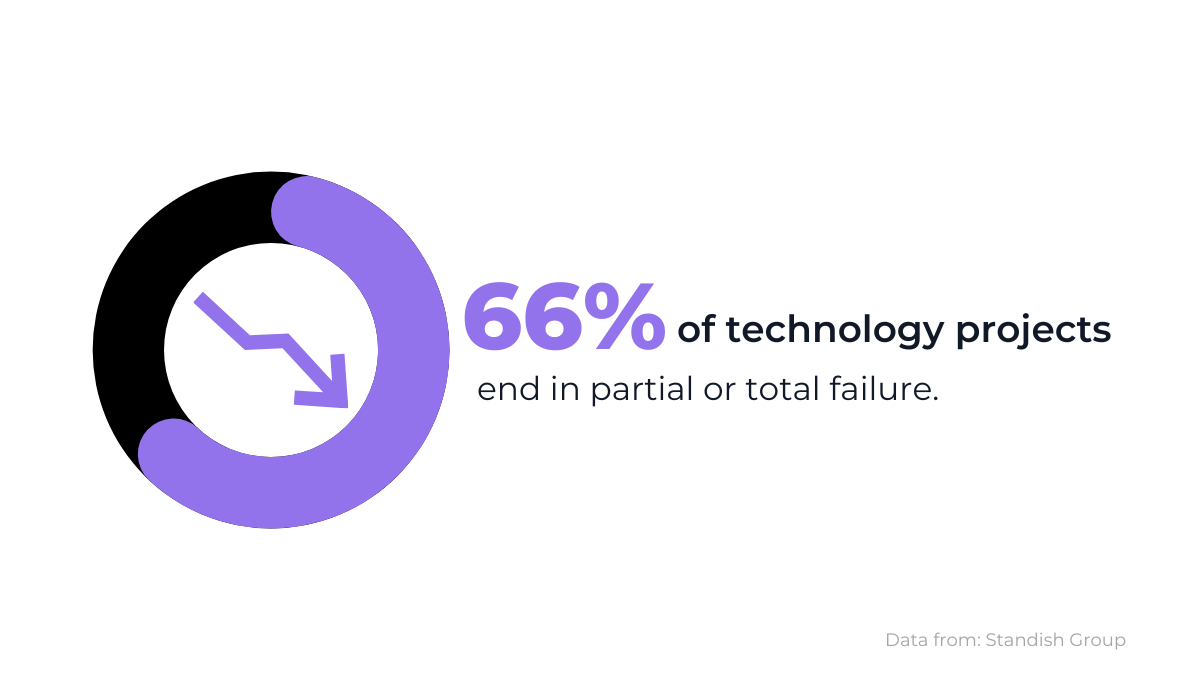
In other words, two-thirds of IT projects aren’t completed as originally designed.
You’ll want to mitigate this outcome as much as possible, and one resource that can help you is precisely a project kickoff meeting.
With a project kickoff meeting, you can ensure everyone involved understands the background of the project and is on the same page about roles, responsibilities, and core aspects.
The meeting is the perfect environment for enabling harmonious collaboration.
A seasoned project manager at Omega Code has spoken about this as well:
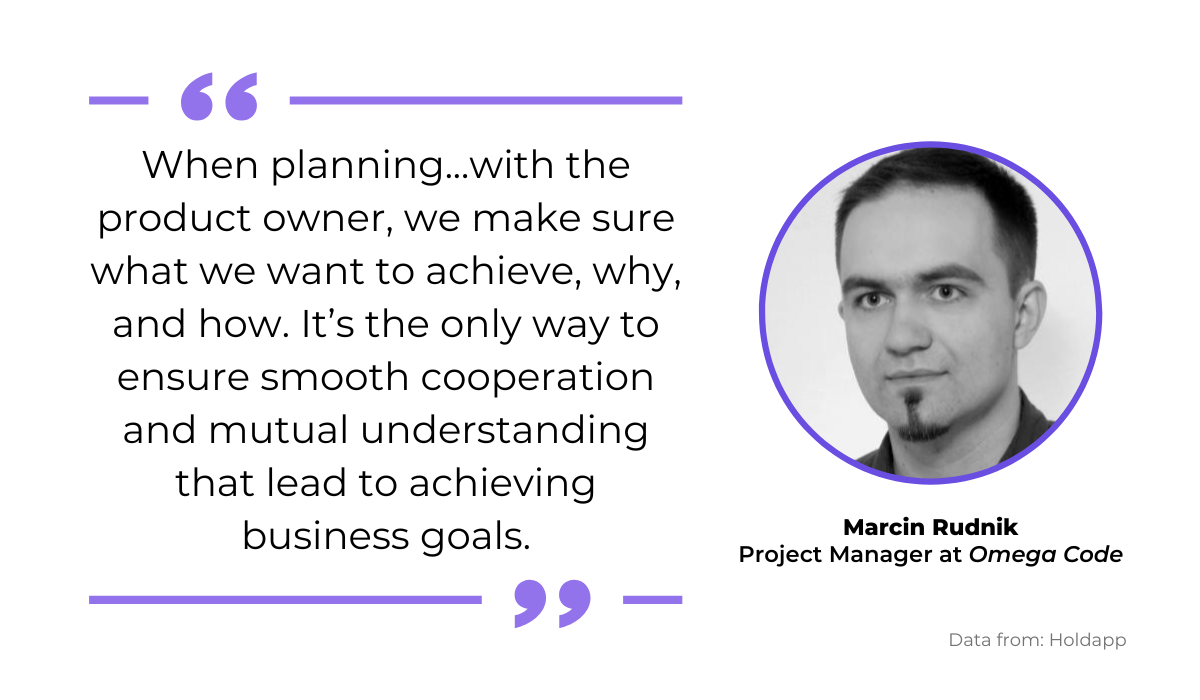
The kickoff meeting is the ideal backdrop for getting all the team members on the same page.
With such seamless alignment, the business objectives should become clear to everyone, which will significantly facilitate the project’s progress.
If everyone understands what you’re working towards, it will be much easier for them to assist one another.
The kickoff meeting is also a golden opportunity to work out the more logistical aspects of the project.
For example, you can decide who will handle what tasks, agree on check-in times, what the deadlines are, etc.
That way, you can establish a project timeline and explain who is responsible for each project aspect.
Who should attend the kickoff
The attendee list for your meeting will vary depending on the type of kickoff meeting you’re holding.
There are three different variations, depicted below:
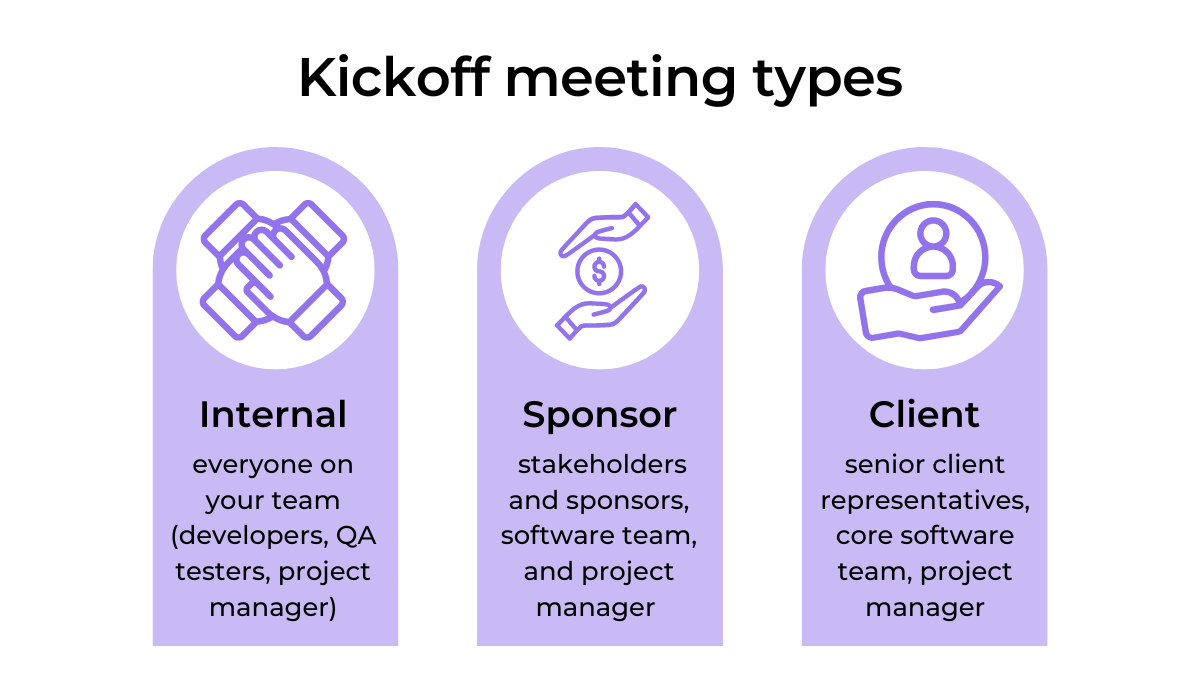
An internal kickoff meeting is your first step when organizing a new project.
A meeting held exclusively with your core team, this meeting will help your developers feel prepared before presenting the project to outside parties.
As such, the only people who need to attend are the software team: your developers, a project manager (yourself or someone else), and possibly QA testers.
A sponsor kickoff meeting introduces stakeholders and sponsors to the cast of the original internal meeting.
This meeting is more or less another chance to obtain the necessary resources and possibly another investment—which is why the stakeholders are there.
This meeting is essential when planning out your workload, as you’ll avoid one of the biggest pains of project planning:
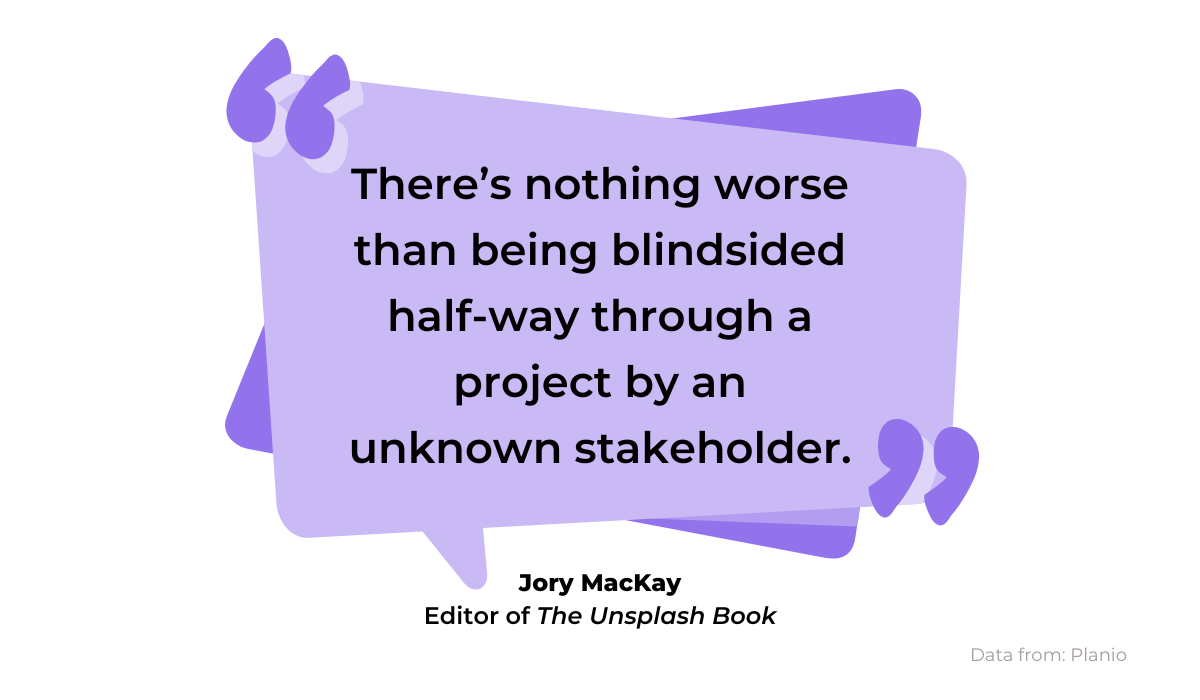
Without a formal kickoff meeting, unknown stakeholders can barge into a project with requirements or expectations that differ entirely from what was initially agreed on.
However, if you invite all the stakeholders to the kickoff meeting, there’s no chance of this happening.
The third and final type of kickoff meeting is with client representatives—preferably senior representatives.
It’s essentially a highly polished, upgraded version of the previous two variants, since you’ll want to impress your client with a well-organized and sophisticated project plan.
Your developers and project manager should also attend to aid with the presentation.
How to structure a kickoff
No meeting is complete without a proper structure—including a kickoff meeting.
Your meeting should follow a structured outline to ensure that you don’t go off-topic or forget any talking points.
It’s always a good idea to design your kickoff meeting structure so that it answers the following questions:
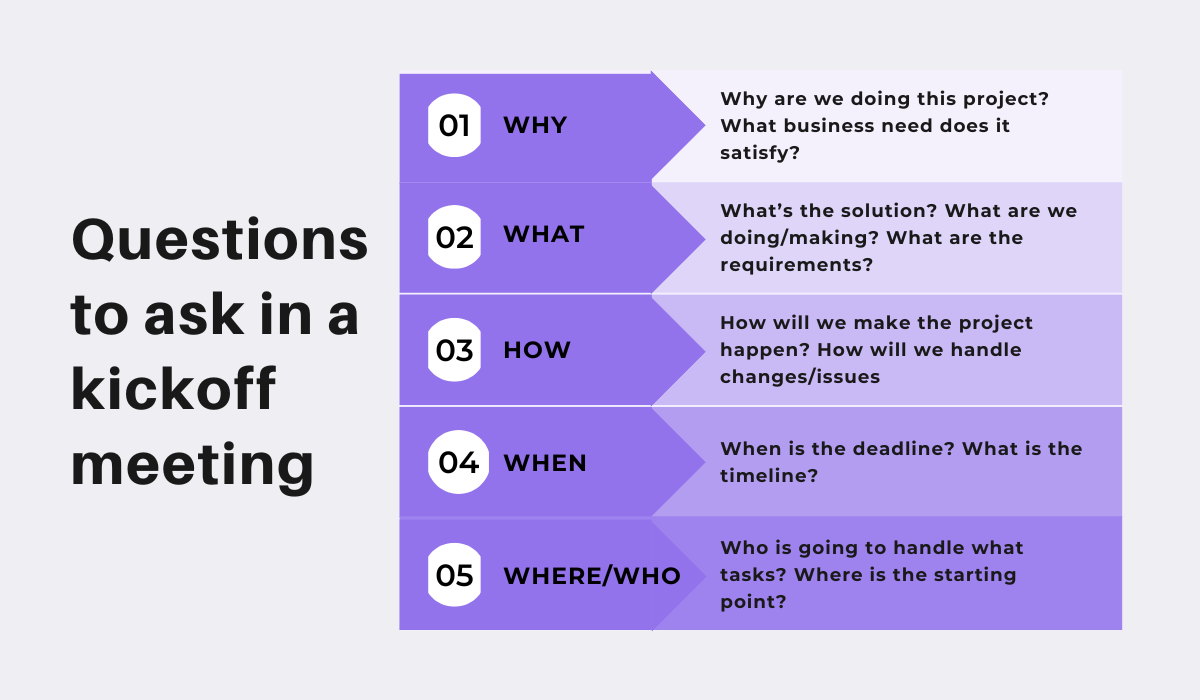
As long as your meeting addresses these points, you can rest assured you’ve devised a quality meeting structure. You’ll need these five answers to ensure a smooth start.
Below is our proposed kickoff meeting arrangement, which incorporates all the elements listed in the table above.
Start with an introduction
The first order of business involves introductions. After all, everyone is working on the same project—they shouldn’t be strangers.
Furthermore, by encouraging the participants to get to know each other, you ensure that, if anyone has any questions or concerns, they’ll know whom to turn to for help.
You can have each individual introduce themselves and clarify their role, or you can say a few words about them yourself.
If you’re summarizing everyone’s positions, do so in a complimentary way.
Say something nice about their work ethic, applaud their completed projects, or even comment on their coffee-making skills. Your colleagues will appreciate the kind words.
Management authorities Ken Blanchard and Spencer Johnson have also commented on this, insisting:
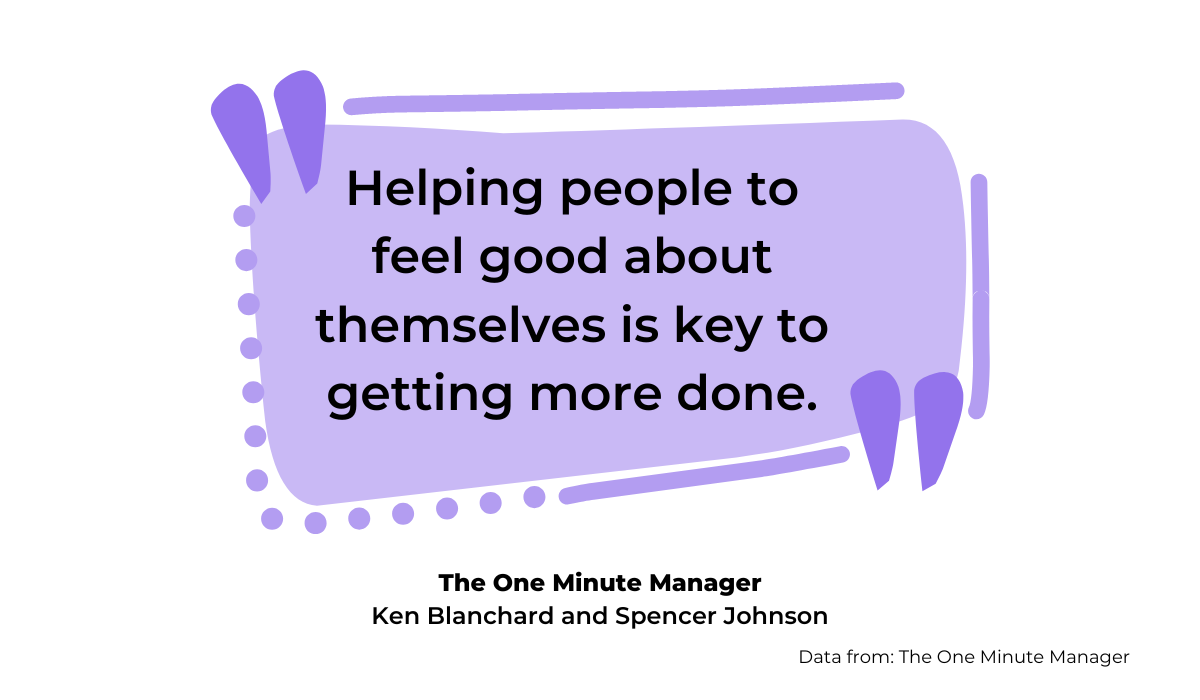
The best introduction inspires positivity in your team members and boosts their confidence.
Another tried and tested method of introducing your co-workers is to ask some icebreaker questions.
Casual and silly, icebreakers provide snapshots of employees’ personal lives and help create conversation.
This IT manager offered his icebreaker proposals in this Reddit thread:
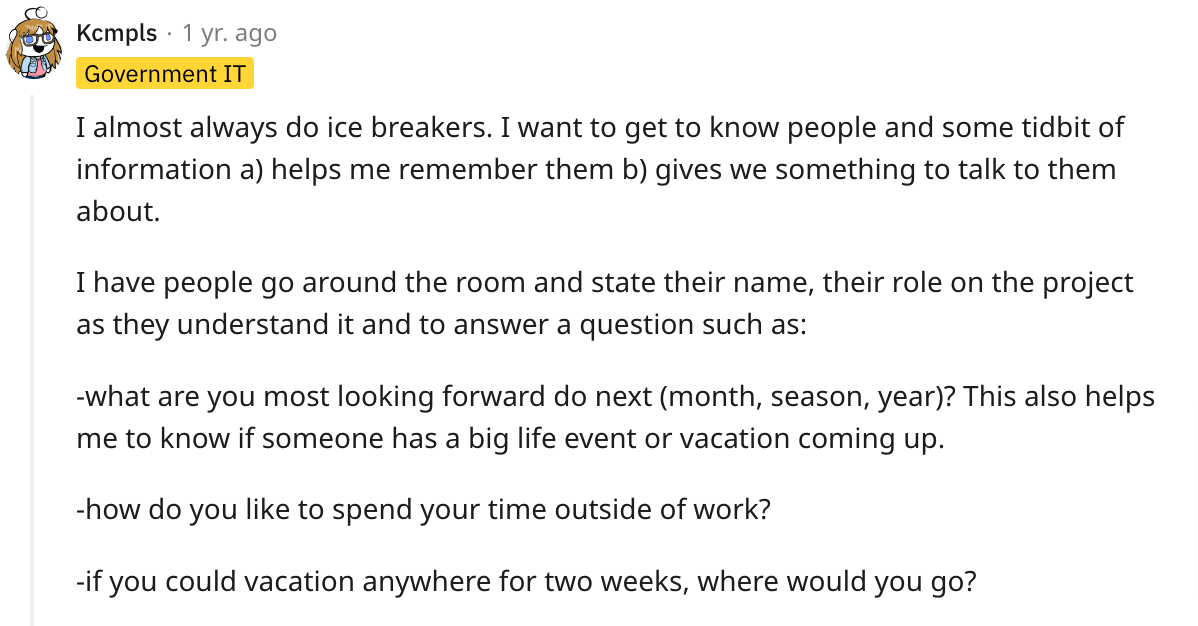
With these fun questions, everyone involved in the project will have something to talk about, as well as retain a token tidbit of information to remember their colleagues by.
Discuss the statement of work (SOW)
Once everyone knows who everyone is, bring out the statement of work.
A comprehensive document that defines the project scope, timeline, budget, and deliverables, treat the statement of work as your project’s Holy Bible.
If you have questions about the project, the statement of work will have the answers.
Here’s a complete list of what the statement of work includes:
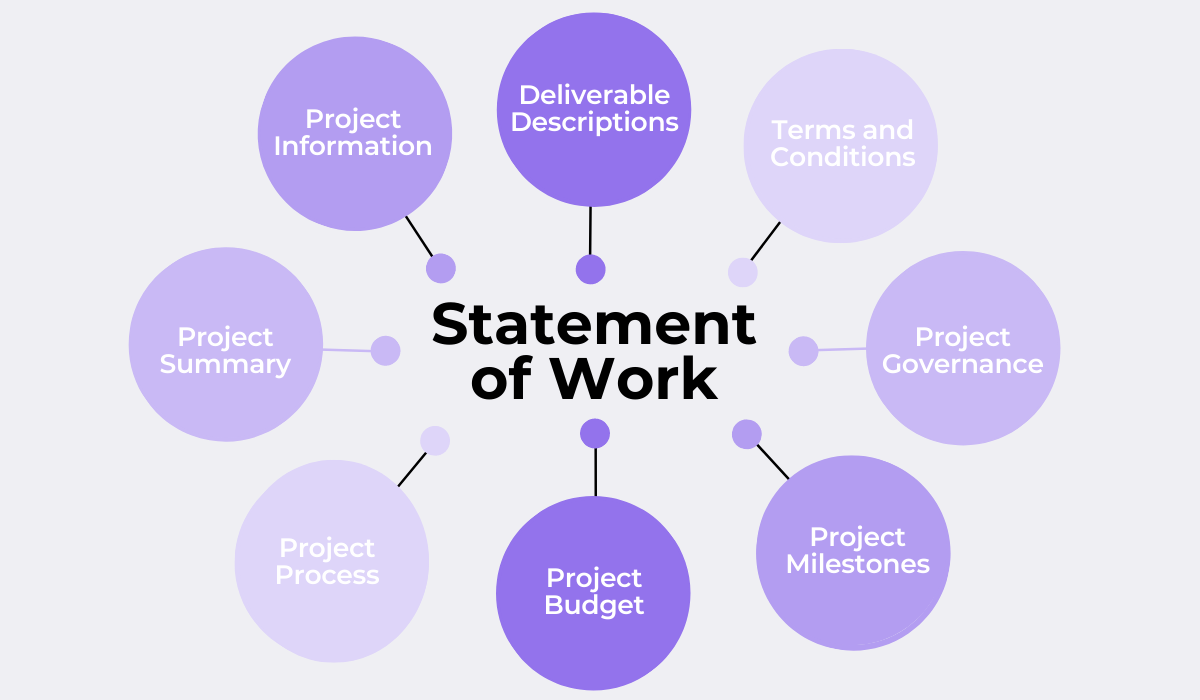
As you can see, the document covers multiple aspects, including milestones, budget, and the project’s progress.
Given its wide range, you’ll want to ensure everyone fully understands its content.
Go over the entire document and clarify anything your colleagues haven’t understood. That way, you’ll know everyone is on the same page about what exactly needs to be done and how.
The statement of work is often used as a guide throughout the project, so verifying that all the information within is correct is essential.
You want your stakeholders and clients to approve the text. In the words of entrepreneur Ben Aston:
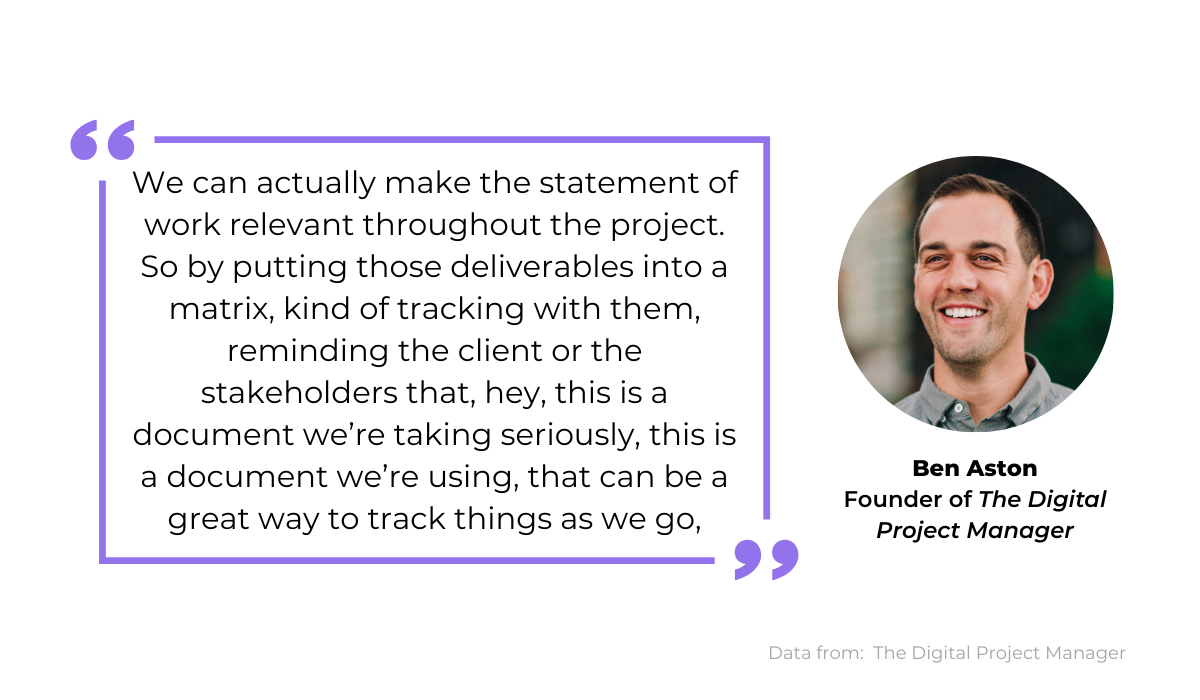
As in Ben’s example, the statement of work will likely be glued to your side throughout the project.
Use the kickoff meeting to ensure the stakeholders understand that and urge them to amend any incorrect information.
Determine project responsibilities
After the statement of work has been ironed out, it’s time to decide who is doing what. In other words, you’ll need to determine your team members’ project responsibilities and tasks.
One of the easiest methods for doing so is the RACI framework. The acronym stands for the following:
- Responsible—the person who is doing the task
- Accountable—the decision maker for the task
- Consulted—the person with unique insights who can advise about the task
- Informed—the person who needs to be kept in the loop
Using these identifiers, you can easily assign specific responsibilities for each task and map out the final decision in the RACI chart. Here’s an example:
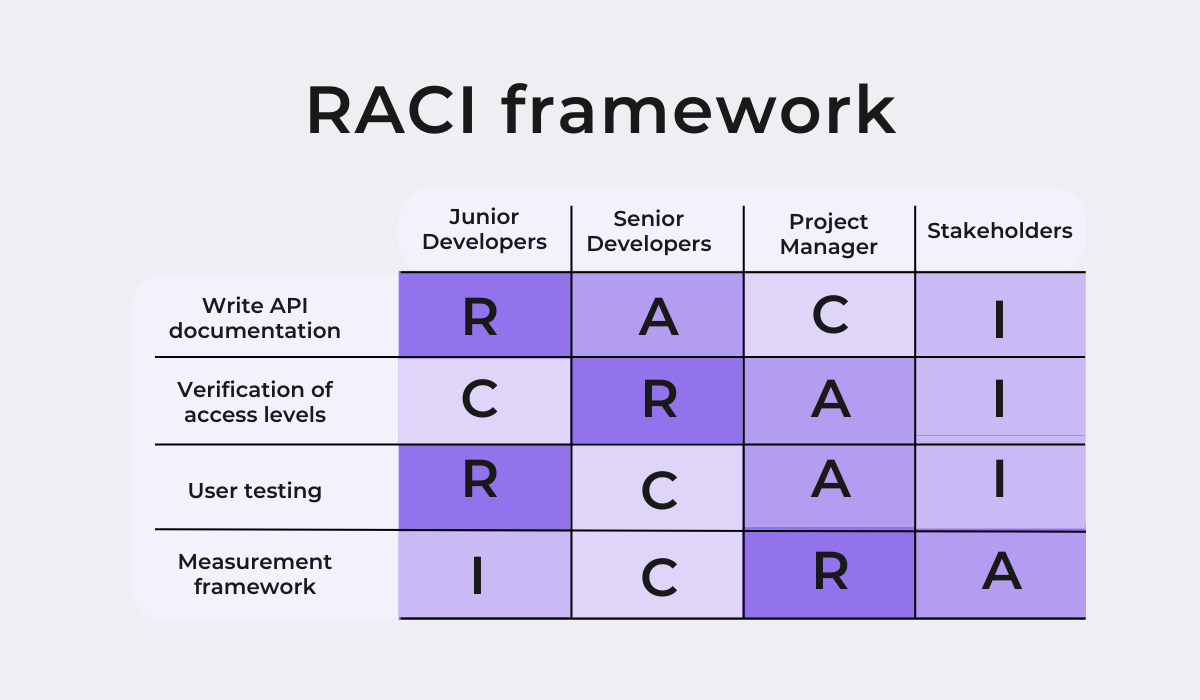
This chart gives you a clear overview of who is responsible for each task and all other roles connected to that task, greatly facilitating project management.
Countless management tools can help you construct your first RACI chart. For example, here is a RACI chart by TeamGantt:
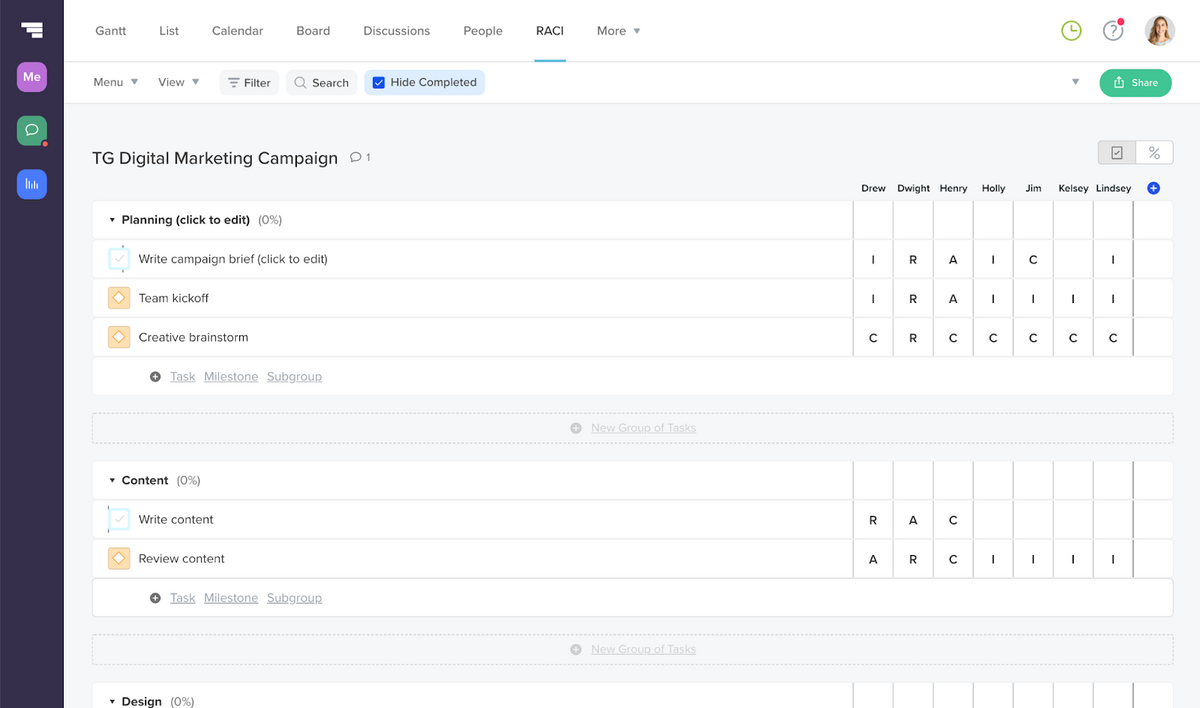
With this template, you’ll be able to construct your first-ever RACI chart.
Furthermore, the chart will be easily visible to all, meaning all your colleagues can access it whenever they need it, significantly streamlining collaboration.
Decide how you will communicate progress
With all the responsibilities divided, the next step is deciding on how you will communicate progress to the client and the stakeholders.
In other words, you’ll need to determine some hard and fast objectives that can provide a benchmark for tracking progress.
Progress can only be assessed with clear, measurable goals. A Harvard Business Review article illustrated this very well:
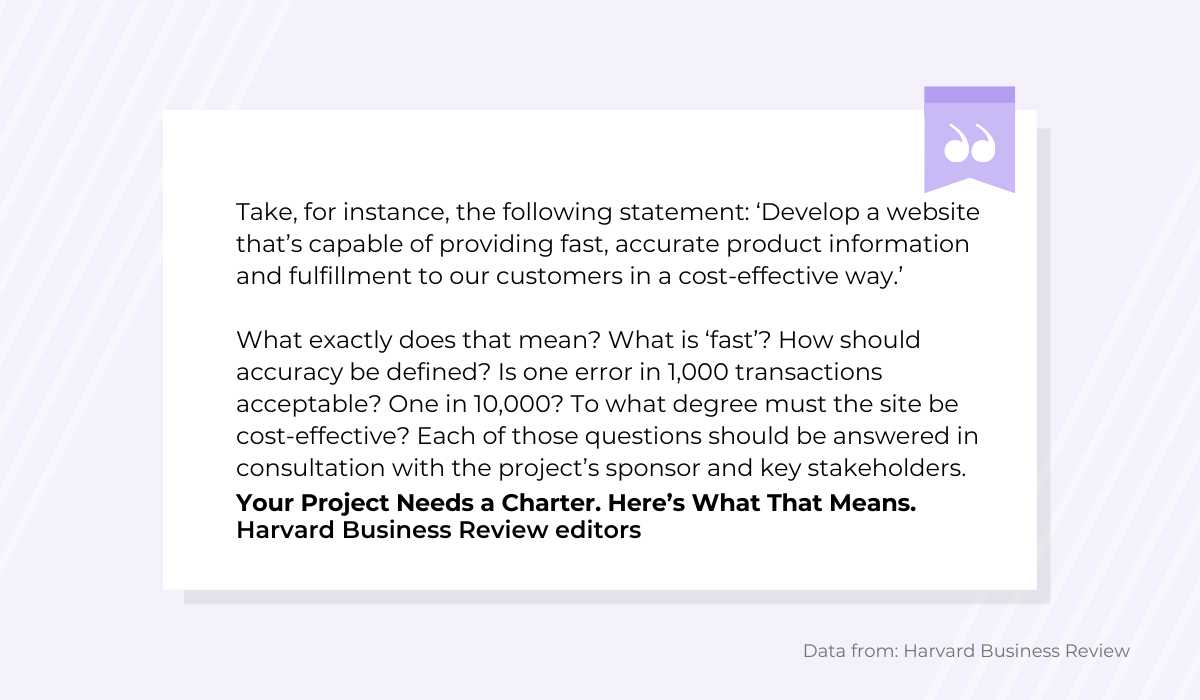
Similar to the example above, you’ll need to define expectations with your team members and stakeholders.
Don’t just ramble off attractive adjectives such as elegant, streamlined, and effective. Instead, sit down and agree on numbers—what is the final aim?
When you have a specific goal, you can then easily update your colleagues on how close you are to that objective.
Similarly, you should devise a meeting cadence, i.e., a guide that outlines how often you’ll formally update your team members and stakeholders.
Here’s an example below:
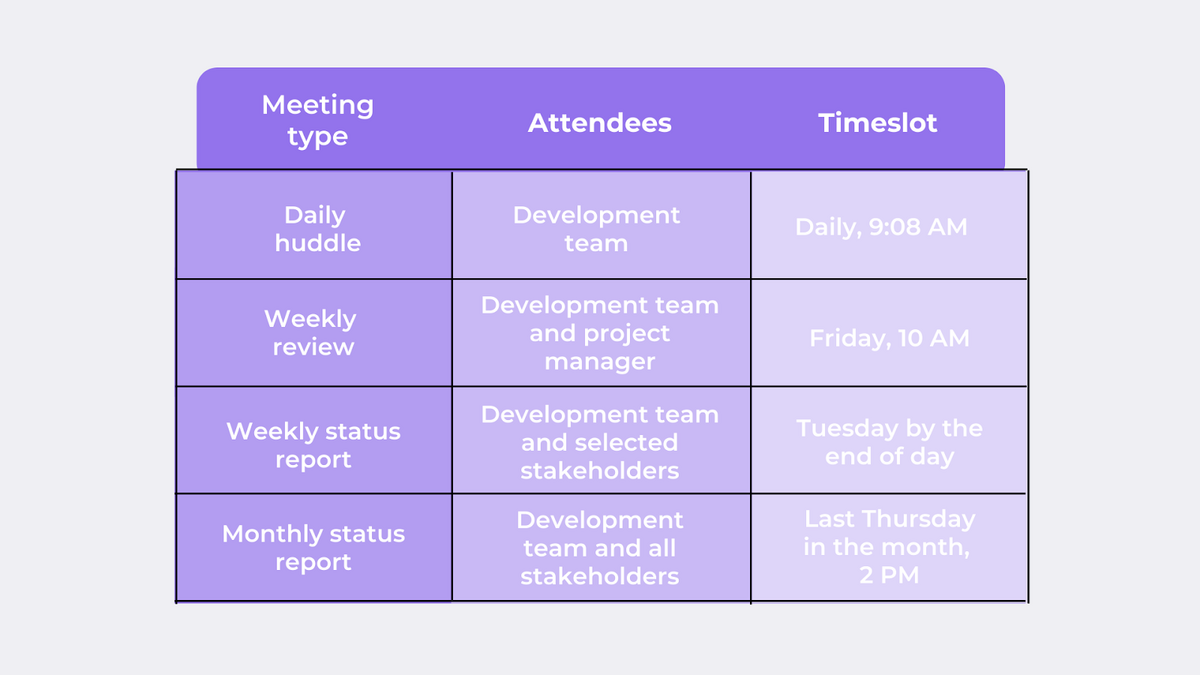
This schedule is a clear-cut communication plan that explicitly defines when everyone involved will meet.
It’s best to decide this during the kickoff meeting, as all relevant parties should be attending and can immediately advise what times and days best work for them.
Agree on collaboration tools
Now that you know when and how you’ll communicate your progress, you should agree on the collaboration tools you’ll use.
These resources will facilitate the project’s progress, as they’ll help your team stay on the same page.
For instance, a shared documentation system is always a good investment.
With such a platform, you can ensure everyone involved (including clients and stakeholders) have access to essential documents, texts, and information.
For example, you could host your statement of work.
Here’s a screenshot from Confluence, one of the most popular documentation tools:
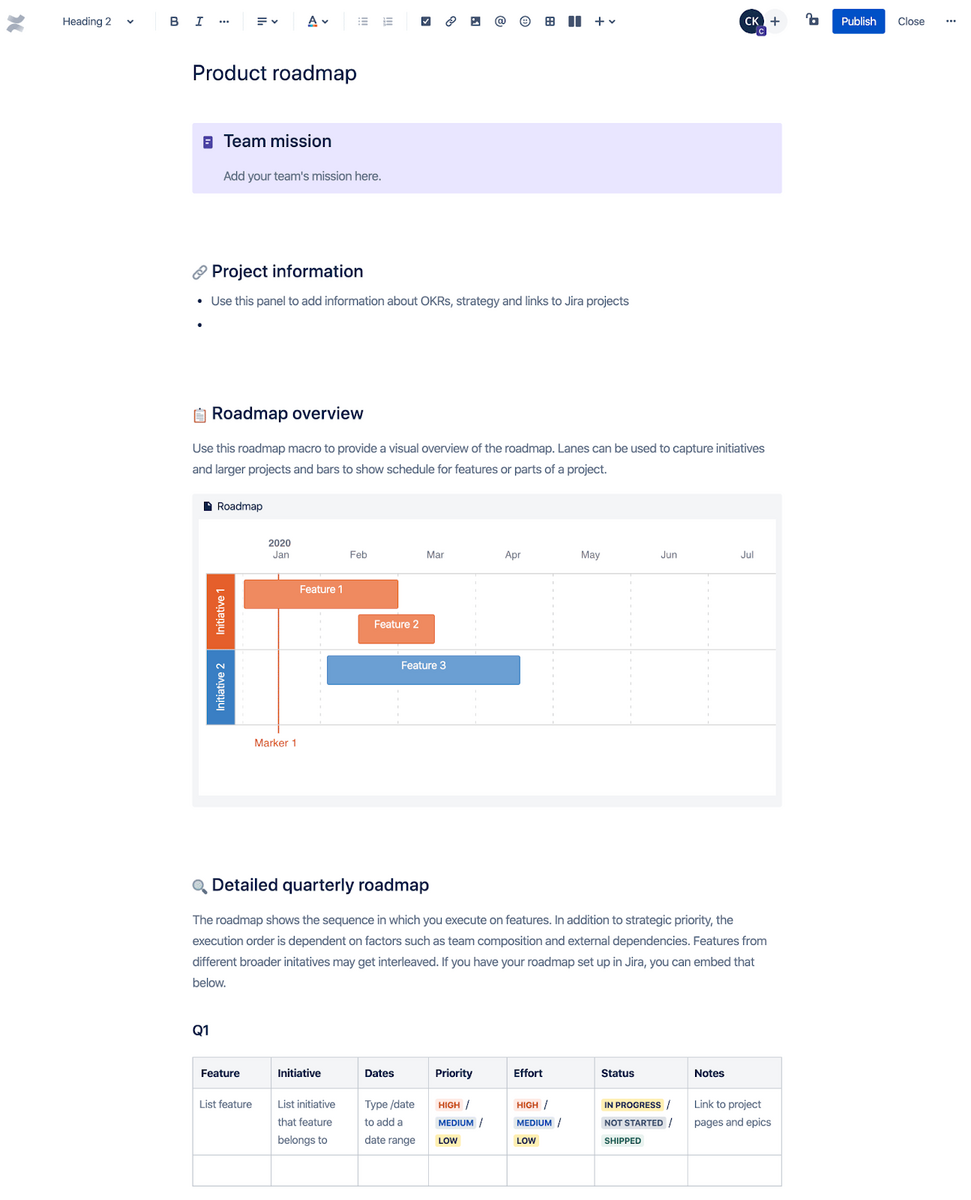
With this centralized documentation system, your co-workers will easily locate the necessary materials without wasting time searching for information.
A communication resource is another essential. Your best bet is an Instant Messaging software such as Slack so that your employees can immediately get in touch if any concerns arise.
It would also be a good idea to open up a Slack channel specific to the project you’re working on.
That way, you’ll have a dedicated space to post updates or ask questions about the project, and everyone involved will be in the loop right away.
Here’s a sample project channel:
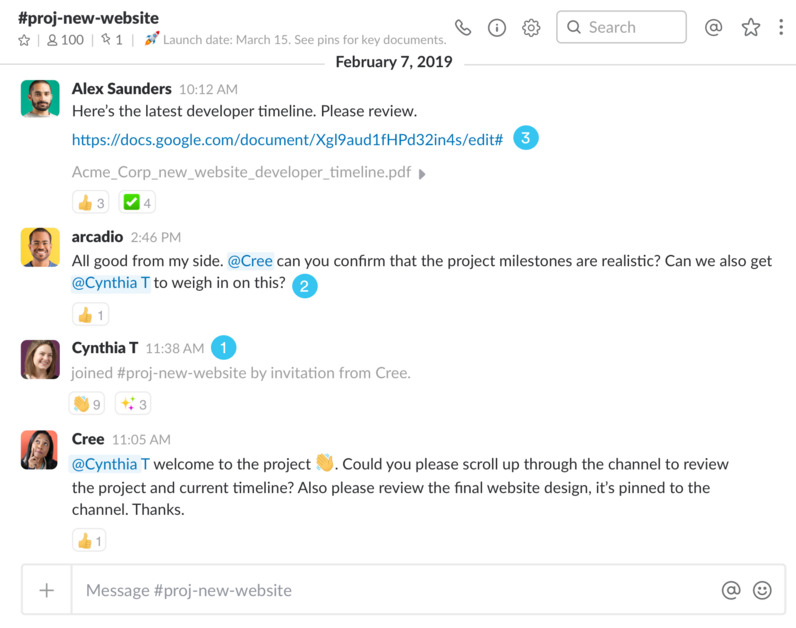
Your co-workers will appreciate having a dedicated channel for discussing the specifics of the project, as they’ll always know where they can go to ask for help.
Leave time for questions
Last but not least, you should leave some time for questions at the end of the meeting.
It’s advisable to reserve a timeslot for anything the team members may be unsure about, as it’s always better to clear up any doubts right at the beginning of the project.
To facilitate this, distribute some documentation before the meeting.

Bug and crash reporting tool for apps that gets you all the right data.
Ideally, this would be a meeting agenda, but if you don’t have time to prepare that, at least share the statement of work for everyone to see.
This way, your team members can prepare for the meeting in advance and will have time to devise insightful questions that haven’t crossed your mind.
A Lucid Meetings representative also mentioned this topic:

The more information you can provide beforehand, the more likely your colleagues will notice any inconsistencies and raise some intuitive inquiries.
If there aren’t any questions at the end, it’s possible that your co-workers are too nervous or embarrassed to tell you what they’re struggling with.
If that happens, ask some probing questions to incite them to open up.
Here are some example questions you could ask:
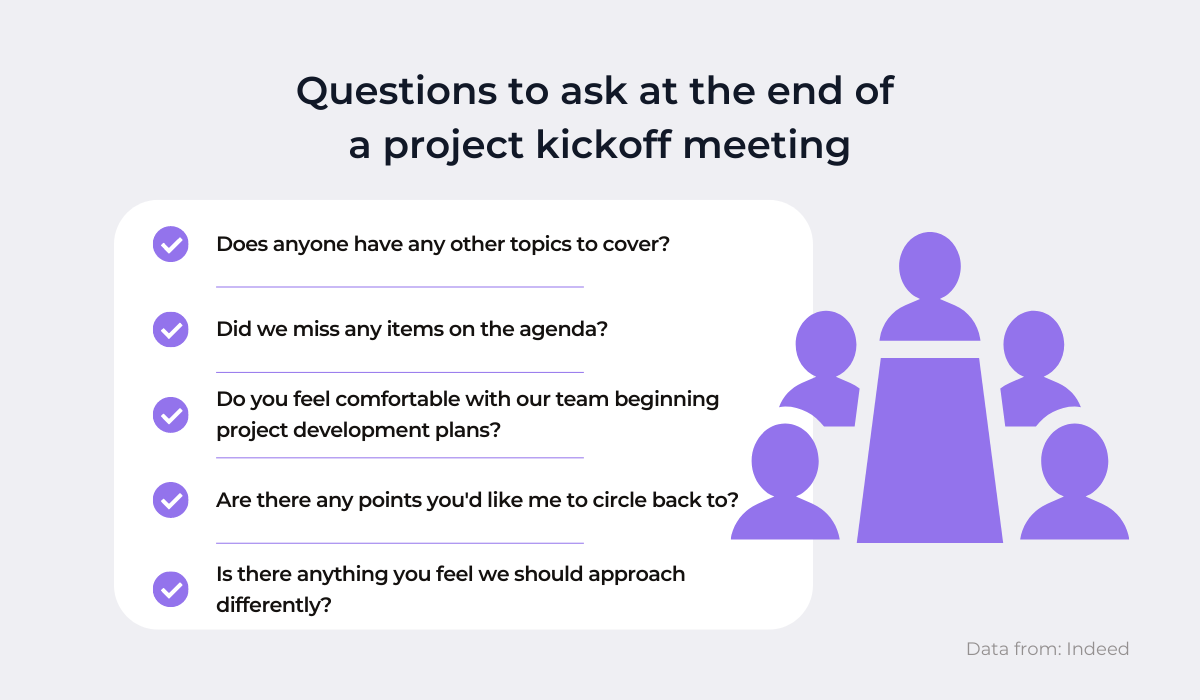
By asking these questions, you’ll communicate to your employees that you’re here as a resource for them, to help them do their best work.
That should then propel them to ask questions about the upcoming project.
Conclusion
When you’re beginning a project, a project kickoff meeting is a must. That kind of meeting helps employees align and ensure everyone is on the same page.
Before meeting with clients and sponsors, however, host an internal kickoff meeting with just your developers.
When structuring your meeting, begin with introductions, and work through the statement of work, project responsibilities, a communication plan, collaboration tools, and, finally, a Q&A session.
Follow these guidelines, and you’ll be able to arrange a great kickoff meeting. And, with your project starting so well, there are high chances it’ll end the same way.




